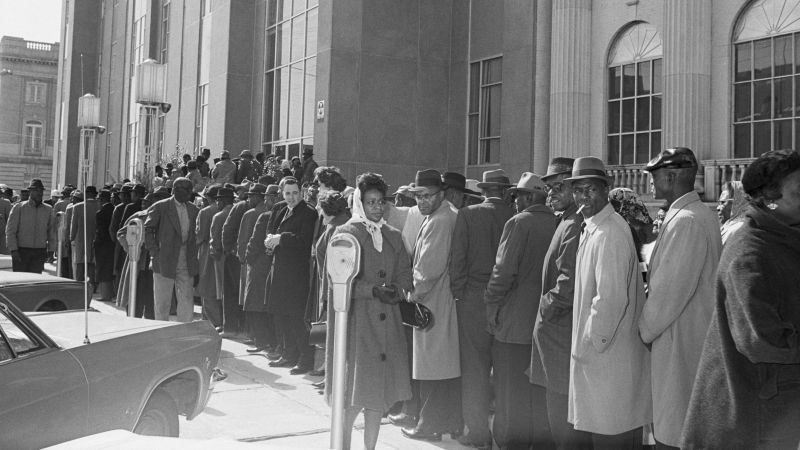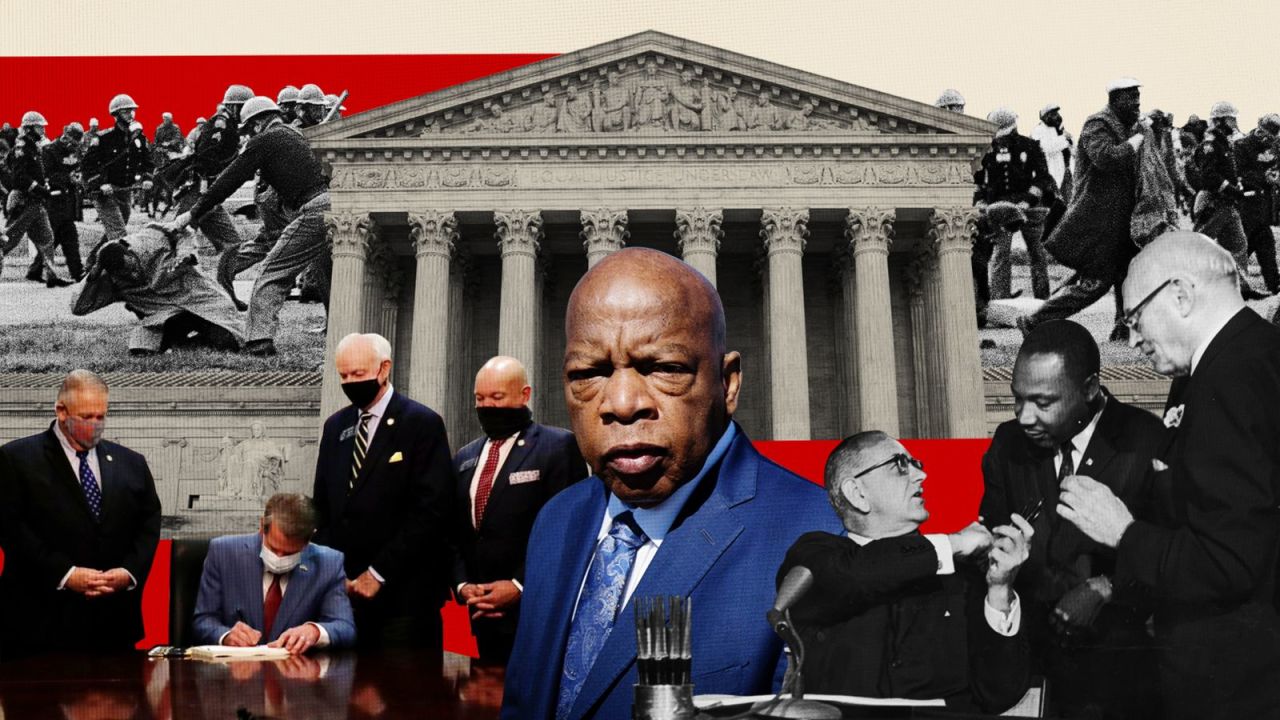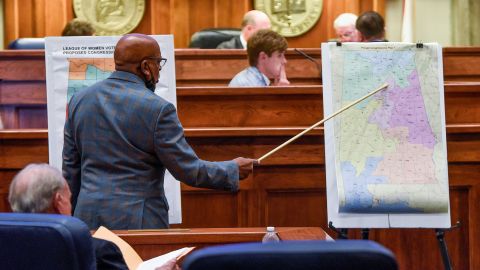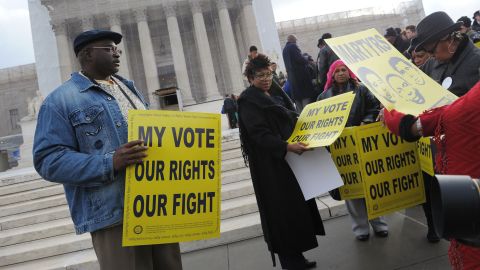
Washington
CNN
—
To Letetia Jackson, voting is as important as drinking water or breathing. She has her mother to thank for nourishing that conviction.
When Jackson was a mere girl in Alabama in the late 1960s, she’d always accompany her mother to the polls. During these trips, her mother would make clear the sanctity of the franchise. And why wouldn’t she? It was only a few years earlier that President Lyndon B. Johnson signed into law the Voting Rights Act of 1965, created to prohibit racial discrimination in voting – to secure a greater degree of equality for Black Americans such as Jackson and her family.
“She would talk with me about how we have a responsibility to exercise our right to vote because people died for us to have that right,” Jackson told CNN. “Even in her 90s, my mother would want me to go get her and take her to the polls. She was determined to cast a ballot.”
Jackson, a public policy advocate, reflected on these formative experiences at an uncertain moment for voting rights. On Tuesday, the US Supreme Court heard Merrill v. Milligan, an Alabama redistricting case focusing on Section 2 of the VRA that bars any rule that “results in a denial or abridgement of the right” to “vote on account of race.” Jackson is a plaintiff in Merrill, one of the most significant election cases in recent years. Depending on how the court decides, Merrill could allow states more latitude to constrain the political power of Black and brown Americans – and shrink their access to public resources on the local level.

“It’s kind of surreal. It feels like we’re starting the fight for the right to vote all over again,” Jackson said. “It’s almost as if we’ve turned back the hands of time.”
Khadidah Stone, a chief field and campaign strategist at Alabama Forward and another plaintiff, echoed some of these sentiments.
“This is a pivotal moment in history, and everyone should be paying attention,” she told CNN. “But also: Why are we even here? Why do we still have to fight for the right to vote?”
Here’s a closer look at how Merrill could affect communities of color:
In Merrill, the bench is reviewing a lower court opinion from January that blocked Alabama’s newly drawn congressional map for likely violating Section 2 of the VRA.
That map includes just one district where Black voters can put their preferred candidate in office, though Black Americans make up 27% of the state’s voting age population.
Because the lower court judges determined that Black voters have “less opportunity than other Alabamians to elect candidates of their choice to Congress,” lawmakers were told to form a second majority-Black district or something quite close to it.

“This decision is a win for Alabama’s Black voters, who have been denied equal representation for far too long,” former US Attorney General Eric Holder said in a January statement released by the National Redistricting Foundation. “The court’s decision reminds us that the moral arc of the universe does indeed bend toward justice – but only when enough people join together and pull it toward justice.”
However, Alabama then asked the Supreme Court to put that ruling on hold. A 5-4 majority granted the state’s request.
One argument Alabama makes is that the harm of the VRA is that it essentializes race – that is, it awards districts to voters based on race and deepens divisions. But that claim gets the VRA completely wrong, per Yurij Rudensky, a senior counsel in the Democracy Program at the Brennan Center, which filed an amicus brief in support of the plaintiffs.
“The trial court (a three-judge panel with two Donald Trump nominees) found that, at most, an average of about 15% of White voters in the relevant region of Alabama (the Black Belt region) were willing to support candidates who were also drawing support from Black voters,” Rudensky told CNN.
This kind of polarized voting can warp how political leaders approach different groups and leads to unequal political opportunities and can perpetuate other disparities.
“The VRA targets actual discrimination,” Rudensky said. “When you have those types of dynamics – where White voters are splitting 85-15 away from the interests of Black voters – then there are tremendous incentives for politicians to harness that racial polarization, to make race a more prominent feature of politics, to use race to drive turnout and drive a wedge between communities that may have otherwise shared economic interests or other interests.”
It’s not the VRA, in other words, that boosts race’s salience in public life but rather the failure to identify and deal with areas that have persistent racial disparities.
“I think that many of the arguments in favor of keeping this congressional map in place and from some of the conservative corners of the court get it exactly backward, in terms of what actually makes race determinative and what’s actually about helping to bridge some of the divides that have plagued communities for decades,” Rudensky said.
It’s hard to overstate the stakes in Merrill.
“This is a very momentous time,” Shalela Dowdy, a student at the Southern University Law Center and another plaintiff, told CNN. “The decision in this case could help shape Black political power across the South.”
It’s worth noting that Alabama isn’t really arguing that the lower court misunderstood the VRA. Instead, the state is asking that the Supreme Court reimagine the rules governing Section 2 claims.
Radically rewriting Section 2, Rudensky said, would “make it much more difficult, if not impossible, for voters of color, as well as civil rights groups and community groups that work with constituencies facing discrimination in redistricting, to find relief.”
In recent years, voting rights advocates have depended more heavily on Section 2 protections, as the VRA continues to suffer death by a thousand cuts.

Most infamously, via 2013’s Shelby County v. Holder, the high court gutted Section 5 of the VRA by freeing jurisdictions with histories of racial discrimination in voting from having to gain federal approval, or “preclearance,” before changing their election laws.
“Throwing out preclearance when it has worked and is continuing to work to stop discriminatory changes is like throwing away your umbrella in a rainstorm because you are not getting wet,” the late Justice Ruth Bader Ginsburg said in her renowned dissent.
The surge in restrictive voting laws following Shelby proved her point.
Crucially, in Merrill, it’s not only the abstract concept of fair representation that hangs in the balance.
“The VRA’s underlying logic is that with political equality comes a more natural resolution to systemic inequities in areas such as education, housing, health care and employment,” Rudensky said. “And the reality is that it bears out. When you look at places where voters of color had been systemically excluded – places that had unbroken legacies of discrimination – and where you saw successful VRA claims, the economic outcomes for Black communities in particular improved significantly.”
Put another way, the VRA has created pathways to the middle class and to economic self-sufficiency for racial groups that have long been marginalized in the US.
Dowdy expressed similar sentiments. More specifically, she stressed that redistricting has a direct impact on the allocation of both power and public resources.
“When the members of a community can elect a candidate who shares their concerns and understands their needs, that’s how real change and empowerment can happen. A lot of times when you go through predominantly Black neighborhoods, our neighborhoods don’t look the greatest. It’s because we don’t always have the right people fighting for us to get the right resources,” Dowdy said.
She added, “It’s as simple as that.”
In the months ahead, seasoned court watchers will have plenty to parse. They’ll scrutinize oral arguments and attempt to suss out where different justices stand on the issue.
On Tuesday, members of the court’s conservative majority appeared to reject Alabama’s more extreme arguments while trying to find a way to preserve the state’s congressional map.
Rudensky said that if past years are any guide, we’re likely to see an opinion released toward the end of the term, because Merrill is such an important case and will probably produce sharp divisions on the court.
Tish Gotell Faulks, the legal director of the ACLU of Alabama, which has been involved in the redistricting litigation, underlined that what’s at stake is the opportunity for voters of color to have their voices heard.
“We’re still fighting old battles,” she told CNN. “It shouldn’t be an open question whether or not Black voters have an equal opportunity to elect candidates of their choice.”
In some ways, Jackson views this moment as a reminder of how valuable the franchise is.
“It feels a lot like we (Black Americans) have never truly been accepted as full citizens of this country,” she said. “And this case is a reminder to our young people, who’ve always enjoyed the right to vote, that our votes do matter. Because if our votes didn’t matter, they (lawmakers) wouldn’t be trying so hard to strip this right away.”
Or as Dowdy put it, “It’s a reminder that we should never get too comfortable.”

